Axis of Rotation Metrology
Article found on pages 36-39.
by Drew Devitt
Founder, Chairman and Chief Technology Officer
New Way Air Bearings
Aston, Pennsylvania, USA
Printed with permission of the Bearings Specialists Association, after appearing as a BSA “Bearing Brief” in January, 2009. Bearing Specialists Association, 800 Roosevelt Road, Building C, Suite 312, Glen Ellyn, IL 60137.
Introduction
In the history of machine tools, spindles have been very good relative to other bearings and structures on the machine. So Quality professionals have developed a cache of tools – like ball bars, grid encoders and displacement lasers – to help them characterize and understand the geometry of the structural loop. But as machine tools have improved in their capability and precision, and the demands of part-geometry and surface finish have become more critical, errors in spindles have become a larger percentage of the total error.
Once you have done all you can to improve the stiffness, damping, geometry and thermal stability of your machine, and the machine operator is using the best machining practices, the next frontier is to study the errors in the spindles. The ultimate roundness and surface finish that may be achieved by a precision metal-cutting machine tool is determined by the performance of its spindles. By characterizing and routinely checking spindles, part quality can be predicted and controlled.
The focus of this article is to summarize the groundwork already established for using spindle metrology to deterministically improve manufacturing processes. As a bonus, and something the pioneers of spindle metrology would all be quick to point out, is that spindle testing, which is defined in the standards now as “tool to work,” is also an excellent new diagnostic tool for other error sources in the machine.
The Standards which most-specifically refer to the quality of precision spindles are: ISO-230-7, “Geometric accuracy of axes of rotation” and ASME B89.3.4-1985, “Axes of Rotation, Methods for Specifying and Testing.” These standards are based on the concept of an “axis of rotation,” which is a line segment about which rotation occurs. Spindle “run out” is an often-used term, but it is not consistent with standards for describing spindle precision. Surfaces have run out; axes have error motions.
There are three basic spatial error motions in spindles: Radial, axial and tilt (Figure 1). We will see later that spindle error motions are also characterized by frequency and by sensitive direction.
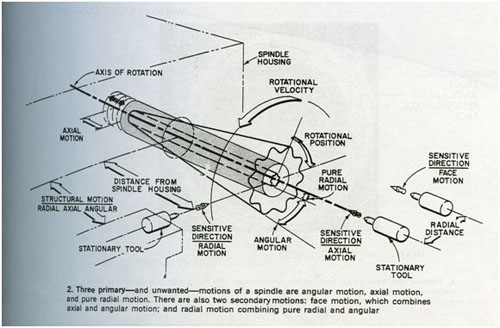
Figure 1
The three primary unwanted motions of a spindle are: Tilt Motion, Axial Motion, and Radial Motion.
There are also two secondary motions: Face Motion, which combines axial and tilt motion; and Radial Motion,
combining radial and tilt error. The term “Angular Motion” used in the illustration above was changed
to “Tilt Motion” in 1970 to avoid confusion with angular displacement of a rotary axis.
How the Testing Was Done
Over the last 50 years, Axis of Rotation Metrology has developed into a standard for characterizing spindles and understanding the capabilities of a machine. The measurement technique involves high bandwidth, non-contact capacitive sensors with nanometer-level resolution. The sensors reference precision pins or spheres that are mounted to the rotating spindle as targets. So with a three-probe system, (two probes arranged radially at 90° from each other, and one axially centered on the axis for X, Y and Z), a point may be referenced in 3-D space. A five-probe system (Figure 2) with two spherical targets may reference two points, and so tilt errors of the spindle may also be known.
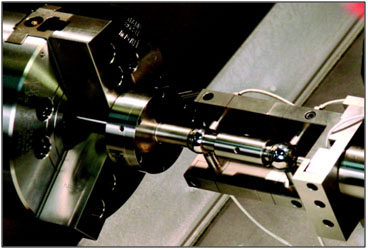
A two-sphere target is chucked in a lathe spindle, and the probe nest with five probes
is attached to the tool turret in order to measure the errors described in Figure 1.
Turning a part would be an example of a fixed sensitive direction.
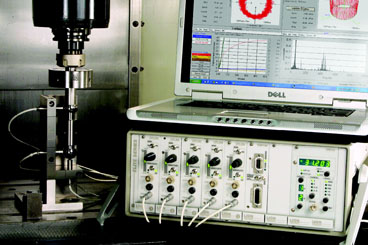
Photograph courtesy of Dr. Eric R. Marsh.
Figure 3
The spindle for a CNC Vertical Machining Center with variable speed, AC motor
and angular contact, ball bearing spindle. The five probes are configured in a stiff nest
for measuring motions of a two-sphere target rotating in the spindle. The probes
will measure the total of: “Bearing error motion,” “structural error motion,”
“target eccentricity” and “target non-roundness.” Boring a hole with this spindle
would be an example of a rotating sensitive direction.
The signals from these five probes each represent a fire hose of information about the spindle’s performance, recording spatial errors and clocking them by frequency. Data can be taken at over 100,000 rpm. The signals may be viewed on an oscilloscope, run though Fast Fourier Transform (FFT) and/or software used to conceptualize the results. (See Figure 3.) Because the spherical artifact is difficult to perfectly align with the axis of rotation, it will have an eccentricity. This eccentricity may be used as a tachometer to phase the data streams with the rotation of the spindle (when an encoder is not conveniently available) and represents an error that is easily subtracted out (like a roundness measuring machine would). This technique allows for phasing a linear data stream (as shown in Figure 7) into polar plots (as seen in Figures 4, 5 and 6.)
What we find in the data, after subtraction of eccentricity, is that some errors are Asynchronous; that is different every time around. If we average the Asynchronous data we have what is called Average Error (per the ASME B89.3.4-1985) now called Synchronous error by the ISO 230-7, and defined as the portion of the total error motion that occurs at integer multiples of the rotational frequency (See Figures 4, 5 and 6.) We will see that asynchronous errors are a main determinant of work-piece surface finish, and synchronous errors are the main determinant of work-piece geometry.
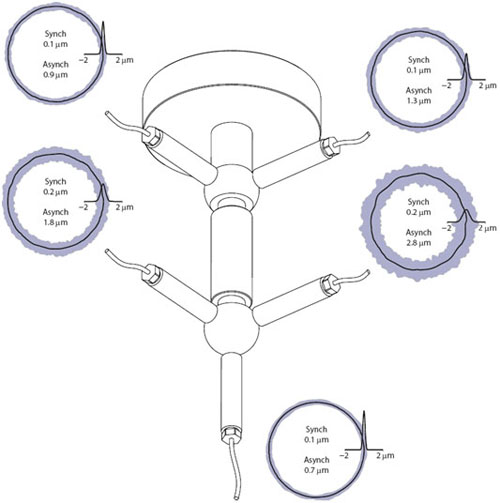
Figure 4
This illustration shows polar plots generated from the individual signals of each of the five probes
Synchronous (Average) Error Motions
After subtracting out the eccentricity mentioned above, and averaging asynchronous motions, we have what’s called “Synchronous Error Motion.” In most cases this would be considered the actual spindle error motion. In cases of very high precision spindles, where the 25 or 50 nanometer errors in the target become a significant percentage of the total error motion, another measurement procedure called “Donaldson Reversal” may be employed to subtract out the errors that are in the target.

Models courtesy of Jim Bryan, from his article: “Spindle Accuracy,”
published in American Machinist, Special Report No. 612, December 4, 1967.
Synchronous (average) error motions are a predictor of how round a hole can be bored or turned with the spindle. So, for example, the synchronous errors of a spindle used to bore bearing seats for other spindles will be the determinate of the roundness of the bearing seats. The roundness of that bearing seat will affect the precision of the manufactured spindle. So the use of spindles with very low Synchronous error motion for boring bearing seats could dramatically improve the precision of the spindles being manufactured.
Synchronous (average) errors are clearly illustrated in plots of air and hydrostatic spindles as the error repeats, for a given speed, every time around. (See Figure 5.) This is, in large part, due to the fact that there is just one rotating element. Error motions in air bearing spindles are often less than 25 nanometers (or one-millionth-of-an-inch). In such a case, Donaldson Reversal would be a necessary methodology as the error motion of the spindle is likely less than the non-roundness of the target.
For a lathe, unbalance, which results in vibrations that you may think would affect surface finish, actually does not. Unbalance causes a once per revolution disturbance that is repeatable. It is a synchronous error. If you have a part in a lathe spindle that is not balanced and you bore a hole in it, it may have good surface finish and roundness but when you slow the spindle down the whole will be eccentric.
With capacitance probes it is possible to measure the eccentricity (run out) of the turned surface at different speeds. With perfect balance, the radial load on the spindle does not change with speed and so there would be no run out at any speed. In a different situation, the unbalance of a grinding wheel spindle will have a surface finish effect determined by the relative speed of the spindle and work piece.
Fundamental axial motion is measured on the axis of rotation. It is very important when flatness or form at the center of the part is important. This would be the case in manufacturing optics. The fundamental face motions are measured some noted distance from the center, and would be the same as the axial motion in the absence of tilt motion. Because they are both measured on the face, both are pure axial motions and so they cause flatness errors when facing parts.
However, fundamental axial face motions will create a part that has the property of circular flatness, that is, the overall surface is not flat, but provides a “flat sealing surface” at any given radius. If you were to put the part on a roundness checker, and measure flatness at some radial distance from the center, you could adjust the part into reading flat at that radius, but the flat surface will not be perfectly square to the axis it was turned on, or the reference surface the part was chucked on. This may be acceptable for a sealing surface, but it would not be a good thing for a bearing surface. The utility of measuring error motions in spindles became evident as hydraulic systems were being applied to military aircraft. Leaky hydraulic fittings were a maintenance headache and a hazard. A study by the military to improve the effectiveness of taper seals revealed that residual face motions of spindles making tapered seals would compromise the geometry of the tapers produced and its ability to seal.
Residual face motions are motions left over after the fundamental (the once around) errors are subtracted; they are still synchronous but are at other integer multiples of the rotation frequency. Residual face motions result in parts that are not flat at all, not even circularly flat. Controlling the property of residual face motion is critical whether you are making seals or bearing races and, because tilt is involved, this is especially true with large diameters.
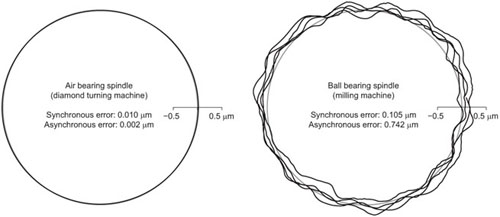
Results courtesy of Dr. Eric R. Marsh, from his book: “Precision Spindle Metrology,’” published by DEStech Publications, 2008.
Figure 5 Figure 6
The difference between fluid film spindles and rolling element spindles is intuitively obvious
when compared in error-motion polar plots. Notice that the air bearing spindle has
Synchronous error of only 10 nm and Asynchronous error is a small fraction of that.
The comparably-sized ball bearing spindle has over 100 nm of Synchronous error
and the Asynchronous error is a large (7X) multiple of the Synchronous error.
This is why an air bearing spindle diamond turning or fly cutting machine can produce
a mirror surface finish, while the rolling-element spindle lathe or milling machine cannot.
Asynchronous Error Motions
Asynchronous error motions are more a predictor of surface finish, and are best illustrated in error motion plots of rolling-element bearings. Because rolling-element bearings have “constituent elements” (rollers, inner race and cages) that are not perfect and have different rotational frequencies, error motions of the spindle appear random. They are not actually random, the determinist view point is that they can be predicted. In rolling-element spindles, these asynchronous motions are generally much larger displacements than the synchronous motions. (See Figures 4, 5 and 6). Over many revolutions, the polar plot develops into a fuzzy band and the thickness of this band represents the asynchronous error motion of the spindle. This is likely to be 100 nanometers in the very best rolling-element spindles; 1000 nanometers (1 micron) in good spindles; and 10 microns or more in 500mm or larger diameter bearings.
The linear plot (See Figure 7) shows how the different elements, with their different rotational frequencies, produce what appears to be non-repeatable motion in the summation of their signals (top). The portion of the signal that is asynchronous is the determinant of surface-finish capability. The error motions do repeat though after many revolutions, and can be predicted to some degree. An analogy can be made with the sun, which rises differently each day but is, after many rotations, repeatable.
Figure 7 also shows that the error-motion signal may be decomposed into frequency components, and that doing so can result in a better understanding of the factors causing observed motion. For rolling element bearings, characteristic frequency equations can predict error motion encountered at specific numbers of rotation that are a function of the geometry of the bearing (diameter of races, number of rolling elements, diameter of rolling elements, etc.)
The Fast Fourier Transform (FFT) is the most common method for separating the frequency components of a signal. An example of this can be seen in Figure 8 for a single row, deep-groove bearing. Note that the cage, ball pass and outer race frequency spikes are identified in the chart. Rolling element bearings can have nanometer (one thousandth of a micron) repeatability when turning though angles of less than 360 degrees and then returning to the starting position. This is because, in less than one revolution, the constituent elements do not precess. That is, all of the components come back to their original locations with respect to each other.
If the error motions of the spindle are plotted for 10 revolutions and then reversed, the error motions will repeat exactly, showing that the motion of the roller-bearing spindle is not random. The gaussian distribution shown in Figure 8 across the asynchronous error band indicating random motion is not correct but is of utility, illustrating at a glance the distribution of the errors in the band.
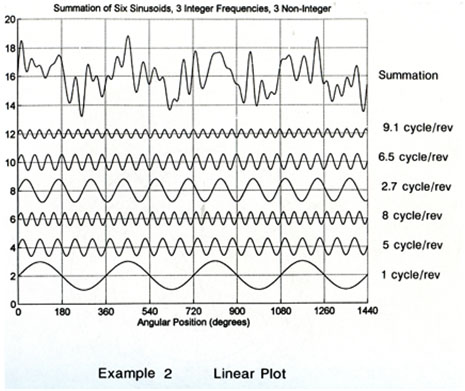
Results courtesy of Wolfgang Holzhauer Ph.D. from his “Tutorial On Axis of Rotation,”
Annual Meeting of the American Society for Precision Engineering (ASPE), November 1, 1999
Figure 7
The signals above represent isolated frequencies from a single signal.
The 1 cycle/rev is fundamental, 5 and 8 cycles/rev are integer multiples
and so these are all Synchronous errors. 2.7, 6.5, 9.1 cycles per revolution
are not integer multiples and so are Asynchronous errors.
The errors, all acting at the same time result in a summation that appears to be random.
When the signal is phased to the rotation of the spindle being measured,
polar plots as in Figure 6 may be generated.
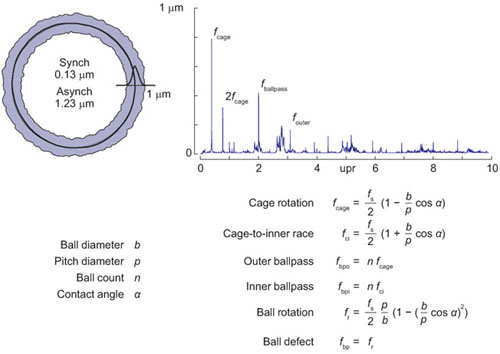
Results courtesy of Dr. Eric R. Marsh, from his book: “Precision Spindle Metrology,’” published by DEStech Publications, 2008.
Figure 8
The above illustrates equations for calculating errors based on the relative size
and number of constituent elements. A typical error motion polar plot, top left;
and an FFT plot showing frequency spikes of critical elements, top right.
Summary
So, what is important if you are selling bearings for spindles? First, talk about Low Error Motions – not “Non-Repeatable-Run Out” (NRR or Run Out) – to show you are familiar with Axis of Rotation Metrology. Remember, error analysis data encompasses all spindle errors, including structural errors both thermal and from external vibrations. Don’t let your bearings get blamed for structural vibration from someone’s coolant pump. Structural Error Motion can be measured quickly and simply by indicating from the tool to the spindle headstock. This is called stationary-point run out. Spindle drive systems can influence and print though into the error motion plot, too. Error at the frequency of the motor supply current is a dead giveaway that this is the case. Thermal drift of the spindle axis as it warms up will be the biggest error, but remember that it affects position, not roundness or surface finish, and is caused by heat, not bearing precision.
If you are manufacturing bearings or spindles, take care that the error motions of your spindles are not limiting the quality of the bearings you manufacture. The synchronous error motions of your work-holding spindles will determine the roundness or flatness of the parts you manufacture. Residual face error motion of work spindles can cause flatness errors of races for large roller bearings. These errors can also change the intended profile of a spherical race. Surface finish is dependent on the asynchronous error motion of both the work spindle and the grinding wheel spindle. Surface finish improvements can be made by characterizing and improving spindles using Axis of Rotation Metrology.
Sidebar 1: Additional Applications
Sometimes the sources of variance in gear teeth contact, surface finish or noise levels can be difficult to identify. Axis of rotation metrology presents techniques that can be used to understand the system where a gear is operating. For instance, these metrology techniques
can be used to separate the error components of the bearing supporting a gear. This would
be “bearing error motion” in the standards.
The shaft or structure supporting the bearing is also likely to be influenced by forces transmitted though the gear or another nearby load path. This is “structural error motion” in the standards.
Basically, even a two-meter diameter slewing ring is an axis of rotation, so the techniques of
axis of rotation metrology designed to evaluate spindles may be use to understand the dynamics of gears mounted on even the largest bearings. The techniques are a powerful tool in identifying where the most cost-effective improvements can be made.
If you are using oil hydrostatic or air bearing supported worktables, your gears may have lower profile errors then the error motions from the rolling bearings they are mounted on in use. Don’t let your gear be blamed for noise that relates to a frequency associated with the rolling elements.
Sidebar 2: Air Bearing Spindles as a Metrology Reference
Air bearing spindles are an excellent metrology standard, they are the basis of most roundness measuring machines. The large gear industry may do well to consider metrology tools based on air bearing spindles that may be brought to the part rather than taking the parts to a very large and expensive Cartesian metrology machines (conventional CMMs). The design below contemplates a light weight, mobile measuring system that would index to be co-axial automatically to within a few microns of a machine tool work table via a kinematic mount. The measuring machine would then act just like typical CMMs with regard to software and probe systems. The part could be measured as machined and again after the unclamping from the fixture to understand chucking distortions and avoid trips back and forth between the machine tool and the CMM. The measuring machine could be moved from machine tool to machine tool or to a dedicated measuring station. In some cases it could attached directly to the part to be measured. This when manufacturing large round parts this would be a powerful way to increase measuring flexibility, measuring precision and reduce costs at the same time.
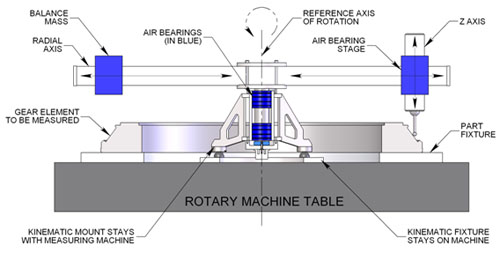
The author, Drew Devitt, is the Founder and Chief Technology Officer of New Way Air Bearings, Aston, PA, USA. He is also Immediate Past President of the American Society for Precision Engineering (ASPE) and a member of the Education Committee for the Bearing Specialists Association (BSA).
ddevitt@newwayairbearings.com
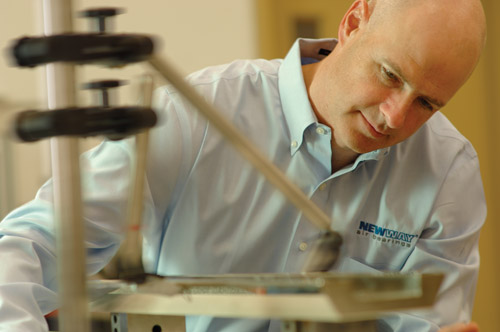
Bibliography
Bryan, Jim. “Spindle Accuracy,” American Machinist, Special Report No. 612, Pages 149-164, December 4, 1967.
Bryan, Jim. “Tutorial On Axis of Rotation,” Annual Meeting of the ASPE, November 1, 1999.
Holzhauer, Wolfgang. “Tutorial On Axis of Rotation,” Annual Meeting of the ASPE, November 1, 1999.
Marsh, Eric R. Precision Spindle Metrology, DEStech Publications, 2008.
Moore, Wayne R. “Foundations of Mechanical Accuracy,” The Moore Special Tool Company, 1970.Donaldson, R. R. “A Simple Method for Separating Spindle Error from Test Ball Roundness Error,” CIRP annals volume 21/, 1972.
References
The author would especially like to thank Jim Brian and Eric Marsh for their effort and input in this work.
Jim Bryan
Precision Engineering Consultant (and the Father of Axis of Rotation Metrology)
Bryan Associates
5196 Golden Road, Suite 3
Pleasanton, CA 94566 USA
Dr. Eric R. Marsh
Professor of Mechanical Engineering
Machine Dynamics Research Laboratory
Penn State University
137 Reber Building
University Park, PA 16802 USA
Wolfgang Holzhauer Ph.D
Timkin Company
Research Specialist
The Timken Company
RES-09, 1835 Dueber Avenue, SW
P.O. Box 6930
Canton, OH 44706-0930 USA
Lion Precision
www.spindleanalysis.com
http://www.lionprecision.com/
Mel Liebers
Professional Instruments
4601 Highway 7
Minneapolis, MN 55416 USA

